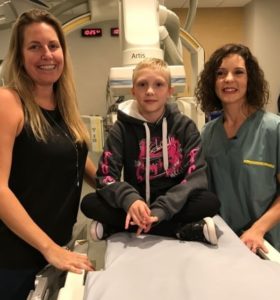
 As the world seems to be changing before our eyes, we are left with the daunting task of coping with it all. How do we rationalize and make sense of such an extreme situation? This is uncharted territory for all of us.
As the world seems to be changing before our eyes, we are left with the daunting task of coping with it all. How do we rationalize and make sense of such an extreme situation? This is uncharted territory for all of us.
The initial instinct is ‘fight or flight’ or panic, which has led to hoarding food supplies and even toilet paper of all things. Retail stores, banks, concert halls, schools, malls, universities, stadiums and restaurants are all closed; sports teams are on hiatus and once busy roadways are now strangely manageable.
We are all left with the task of learning social distancing, elbow bumps, frequent hand washing and sanitizing anything that is ever touched. There is no where to go and not much to do as we all try to figure out what happened to the world we knew just a few weeks ago?
So now, with all sorts of time on our hands, we can get to the business of gathering important information, but where do you turn and who do you trust? 24-hour news outlets have time to fill, competitors to beat and advertisers to satisfy.
Sure, they want to report what you need to know, but to support their bottom line, they need to keep you tuned in and the best way to do this is to maintain a sense of urgency and fear. If we take the bait, we get sucked into an emotional roller coaster resulting in significant ongoing stress and hopelessness. Overtime this can affect sleep, appetite, mood and overall healthy well-being.
So what do we do? What do we actually have control of? We can certainly control how and when we gather daily news updates. We can control the frequency our physical activities like healthy exercise which stimulates endorphin flow creating a sense of euphoric relaxation.
We can also seek out uplifting stories that have resulted from this tragedy like the Italian residents singing together from their apartment windows as a sign of unity. Or the police officer in Somerville, MA who handed out toilet paper instead of tickets
 As a hypnotherapist, I teach my clients to control their pattern of thought, how they think and what they most frequently think about. Hypnosis or meditation is a great way to emotionally disconnect from outer world thoughts and to focus within; to spend more time thinking about and anticipating sustained comfortable relief.
As a hypnotherapist, I teach my clients to control their pattern of thought, how they think and what they most frequently think about. Hypnosis or meditation is a great way to emotionally disconnect from outer world thoughts and to focus within; to spend more time thinking about and anticipating sustained comfortable relief.
By repeating this process daily the subconscious becomes conditioned to follow this new relaxing path. You will still be doing what you do and going where you go, but you will feel much better about it. We can’t control what comes our way but we most definitely have control over how we see it and more importantly how it makes us feel.
You don’t necessarily need to see a hypnotherapist or attend a meditation class to get the job done. There is no shortage of great meditation apps as well as an endless array of free hypnosis sessions on YouTube. You will be pleasantly surprised how much better you’ll feel in the middle of everything that is going on around you.
By: Paul Gustafson RN CH

Jessica used hypnotherapy to overcome her extreme anxiety.

 Some 80 pediatric patients took part in pilot project to test effect of hypnosis during stressful procedures.
Some 80 pediatric patients took part in pilot project to test effect of hypnosis during stressful procedures.
Even in a quick demonstration, Vicky Fortin, medical imaging technologist, was able to guide 9-year-old Koraly Lefrançois into a dreamlike state with hypnosis.
Koraly Lefrançois was diagnosed with Hodgkin’s disease last April and has had to undergo some pretty uncomfortable medical procedures at the Montreal Children’s Hospital since then.
The nine-year-old has had a catheter inserted into a peripheral vein and threaded through to her heart, in order for lifesaving treatments to be injected. She underwent a biopsy when a growth was discovered on her inner thigh.
In both procedures, a local anesthetic was used to ease her pain. But that does little to soothe anxiety.
That’s where hypnosis comes in.
“At first I was stressed, but after, I was less worried,” Koraly said. “The hypnosis calmed me down, and I was fine.”
Koraly is one of about 80 pediatric patients who participated in what is being touted as a successful pilot project at the Children’s — the use of medical hypnosis as a tool to combat stress and pain when undergoing arduous, protracted procedures.
On a pain and discomfort scale of zero to 10 (10 being the highest), the young patients averaged a score of 5.4 without hypnosis, researchers found.
Under hypnosis, the average score drops to 1.4. That’s a huge difference, said Johanne L’Écuyer, chief medical imaging technologist at the  Children’s.
Children’s.
Inspired by hospitals in France
L’Écuyer, who led the project, said the research team started with minor procedures, working their way up to longer, more difficult ones. The project ended in September, and now the use of hypnosis is increasingly common, she said.
“We do more and more. We do even more invasive procedures as we go,” L’Écuyer said.
“The more radiologists are seeing how powerful this is, the more they push to have hypnosis on longer procedures. Once we did a procedure that lasted two hours.”
Johanne L’Écuyer, chief medical imaging technologist at the Montreal Children’s, led the hypnosis pilot project. Hypnosis is now being used more and more, she says. (CBC)
The pilot project was initiated at the urging of Quebec’s order of medical imaging technologists. The order’s director attended a conference in France a few years ago and discovered the practice in use there.
When he returned to the province, he asked L’Écuyer if she’d like to look into it.
 She said she brought a team to France to visit hospitals, and “what we saw there was amazing.”
She said she brought a team to France to visit hospitals, and “what we saw there was amazing.”
Anne Zeestraten, left, says her daughter Koraly Lefrançois benefited from the hypnosis. Vicky Fortin, Koraly’s medical imaging technologist, says she could see her patient dreaming.
Koraly, who is now in remission, would dream while hypnotized, according to her medical imaging technologist, Vicky Fortin. Fortin would tell her young patient a relaxing story while she underwent each procedure.
“You could see her eyes moving under her eyelids, and that tells me that she’s dreaming,” Fortin recalled.”She’s somewhere else. She’s under hypnosis.” Koraly’s mother, Anne Zeestraten, said with the hypnosis, her daughter wasn’t scared when told she had to undergo a second procedure.
“She was like, ‘OK, yeah, just find some other dream.'”
By: Isaac Olson

 When my anxiety and insomnia returned, my therapist suggested a new form of treatment. The results challenged my inner skeptic. I hadn’t slept more than two hours a night. It was the summer of 2016, and I had spent all night with my face in my palms, shaking in the bathroom of my Brooklyn third-floor walk-up.
When my anxiety and insomnia returned, my therapist suggested a new form of treatment. The results challenged my inner skeptic. I hadn’t slept more than two hours a night. It was the summer of 2016, and I had spent all night with my face in my palms, shaking in the bathroom of my Brooklyn third-floor walk-up.
The 3 a.m. stroll in my neighborhood that my boyfriend encouraged me to go on with him had the opposite effect of a Xanax, and the speed of my anxious thoughts was physically excruciating.
I was in the midst of a new trial of antidepressants — my Lexapro stopped working after seven years — and I had been engulfed in anxiety-induced insomnia since college, the kind where sleep doesn’t exist without the use of prescription sleep aids. I was so tired, but my anxiety made me fear rest.
I made a decision: I’d check myself into a psychiatric hospital. When my boyfriend woke up, I told him my plan, while attempting not to drown in my shame. “Babe, there’s nothing wrong with going to a doctor or a hospital,” he told me. “If you broke your arm, that’s where you’d go.”
Before I left for the hospital, I decided to call my therapist for her advice. She revealed she had an alternative treatment idea for me, cautioning me to “be open.” “You need to go to Joanne. She’s a miracle worker,” she told me. “What does she do? I don’t understand,” I said.“She’s a hypnotist,” she replied.
Before that summer, I had assumed hypnosis involved mind control, a pocket watch swinging in front of my face and me unknowingly word-vomiting my secrets. But after hitting rock bottom with my depression, anxiety, insomnia and obsessive-compulsive disorder after a layoff from my media job, I was willing to try anything.
At that point, life had become an amalgamation of “Groundhog Day” and “Russian Doll.” It was an understatement to say that the cocktail of  mental health issues I suffered from was suffocating me. Some days, the extra energy I had made my job as a writer easy — people called it hustle, I called it keeping myself sane.
mental health issues I suffered from was suffocating me. Some days, the extra energy I had made my job as a writer easy — people called it hustle, I called it keeping myself sane.
Other days, I could barely get out of my wrinkled T-shirt and queen-size bed. I had to silence my inner skeptic. I was a high-functioning zombie who had hit rock bottom, so what did I have to lose?
If hypnosis had the power to save me, I’d be a fool not to give it a try. What was slightly comforting to me was that research proved that hypnosis wasn’t just a woo-woo concept, and that it did, in fact, have effects.
A 2016 study conducted by Stanford University School of Medicine found changes in three areas of the brain when people are hypnotized and 2013 findings from the University of Quebec in Montreal revealed that “the short-term effects of hypnosis (one-two months) and relaxation training were comparable to the effects of short-term drug therapy, and that the long-term outcomes even surpassed the drug therapy in certain instances.”
Just a few weeks later, the already overbooked Joanne made time for me in her schedule. Two trains, a cab and three hours later I sat in a dimly lit corner office of a wellness center on Long Island.
Our session began like any talk therapy appointment as she listened to me relay an abridged version of my trauma, in between my dry-heaving — how it had been seven years since I had been in the throes of anxiety-induced insomnia, how my medication stopped working, how the weight of my body was crushing me and how losing my job and going freelance had imprisoned me on a hamster wheel of worry.
 Near the end of our conversation, she asked me to lie back in a red leather recliner and “relax” — a word truly no person with anxiety fully comprehends. “Do you trust me?” she asked. “Yes, but I’m worried hypnosis won’t work on me or that this is some kind of fake energy thing.” “I get it,” she said. “But in a few sessions, you’ll believe in it.”
Near the end of our conversation, she asked me to lie back in a red leather recliner and “relax” — a word truly no person with anxiety fully comprehends. “Do you trust me?” she asked. “Yes, but I’m worried hypnosis won’t work on me or that this is some kind of fake energy thing.” “I get it,” she said. “But in a few sessions, you’ll believe in it.”
Soon enough, musical chimes rang in my ears as my eyes fluttered shut. For 20 minutes, my mind floated in darkness as Joanne read a nonsensical script full of “suggestions” — straightforward statements that create a hypnotic state — for my overworked thoughts.
As she recited a slew of jumbled words, it felt as if a magic wand was sprinkling tranquility around me like glitter. A tingling overcame my body as the chimes circled my brain like waves.
And with that, a small part of my unease was sucked out of my body. By the end, she counted to five and my eyes struggled to open from what felt like a deep meditation. My mind didn’t feel controlled but slightly calmer.
Joanne told me I’d notice the changes in two to three days; they would be small, but the anxiety and depression would begin gradually lifting, and sleeping wouldn’t be as much of a chore. I was to visit her two to three times a week and listen to a 30-minute hypnosis recording nightly before I went to bed.
Despite having done reiki and meditation, the stigma of hypnosis stuck with me at first. But I listened to Joanne and followed the simple  instructions given to me.
instructions given to me.
The first night I listened to the recording, my body tightened at the mere sound of the woman’s voice. The words filling my ear felt like a 30-minute prison sentence: I forced myself to keep my eyes shut while trying to quiet the stifling anxiety in my body.
Weeks went by, and I didn’t feel anything, but Joanne encouraged me to keep with it. After two months of doing so, I felt something shift. As if a string of yarn was slowly spinning off a spool, I became slightly more at ease.
I was militant in my regimen — a combination of my O.C.D. and a willingness to do whatever it took to get better. I became a master at self-hypnosis, all the while traveling to Long Island more than I ever had before.
It became harder to pinpoint what had changed and when it had, but it had. Just six weeks in, I began sleeping through the night and found myself wanting to escape the walls of my apartment; nearly three months later, my constantly quivering foot stopped tapping.
I gained a newfound optimism that fed me as my body coped with the trauma it had been through. I believed in hypnosis like people believed ![]() in God.
in God.
For six months I stuck to that routine until one day I was back in my body again: no longer crying, no longer wearing the same distressed tee; I was sleeping without the aid of medication again.
 What I learned was that people who are struggling with phobias, trauma and other mental health problems can see results with hypnosis if they’re open to it, as I had been.
What I learned was that people who are struggling with phobias, trauma and other mental health problems can see results with hypnosis if they’re open to it, as I had been.
But I would be lying if I said I don’t find myself spiraling from time to time. Hypnosis isn’t necessarily a “cure”; it’s a tool. Sometimes when I find myself stuck in a “cycle,” I take a breath and remember that I know what to do.
I play my recording, shut my eyes and find comfort in the monotonous audio that has saved me so many times before. Some people might unwind with meditation apps, but I have my own personalized one that will put me and my body to sleep.
By: Ilana Kaplan

 This study assesses the effect of hypnosis for insomnia with school-age children, ranging from ages 7-17, dealing with stressors and medical conditions.
This study assesses the effect of hypnosis for insomnia with school-age children, ranging from ages 7-17, dealing with stressors and medical conditions.
The study included 84 children and adolescents with insomnia. All were instructed in self-hypnosis for treatment of insomnia.
Seventy-five patients returned for follow-up after the first hypnosis session. When insomnia did not resolve after the first instruction session, patients were offered the opportunity to use hypnosis to gain insight into the cause.
Use of hypnosis appears to facilitate efficient therapy for insomnia in school-age children. 87% reported improvement or resolution of the somatic complaints following hypnosis. [more]

 In an effort to evaluate the reduction of emotional and physical disturbances in patients scheduled for breast biopsy, this study compared audio-recorded hypnosis with background music vs. music without hypnosis. It also included a control group.
In an effort to evaluate the reduction of emotional and physical disturbances in patients scheduled for breast biopsy, this study compared audio-recorded hypnosis with background music vs. music without hypnosis. It also included a control group.
A total of 75 patients were randomly assigned to a group and evaluated before and after breast biopsy for levels of stress, pain, depression, anxiety, fatigue, optimism, and general well-being.
The results showed that, before breast biopsy, the music group presented only less stress and anxiety, whereas the hypnosis group presented reduced stress, anxiety, and depression and increased optimism and general well-being.
After the biopsy, the music group presented less anxiety and pain, whereas the hypnosis group showed less anxiety and increased optimism. [more]

 As the world seems to be changing before our eyes, we are left with the daunting task of coping with it all. How do we rationalize and make sense of such an extreme situation? This is uncharted territory for all of us.
As the world seems to be changing before our eyes, we are left with the daunting task of coping with it all. How do we rationalize and make sense of such an extreme situation? This is uncharted territory for all of us.
 As a hypnotherapist, I teach my clients to control their pattern of thought, how they think and what they most frequently think about. Hypnosis or meditation is a great way to emotionally disconnect from outer world thoughts and to focus within; to spend more time thinking about and anticipating sustained comfortable relief.
As a hypnotherapist, I teach my clients to control their pattern of thought, how they think and what they most frequently think about. Hypnosis or meditation is a great way to emotionally disconnect from outer world thoughts and to focus within; to spend more time thinking about and anticipating sustained comfortable relief.


 Some 80 pediatric patients took part in pilot project to test effect of hypnosis during stressful procedures.
Some 80 pediatric patients took part in pilot project to test effect of hypnosis during stressful procedures. Children’s.
Children’s. She said she brought a team to France to visit hospitals, and “what we saw there was amazing.”
She said she brought a team to France to visit hospitals, and “what we saw there was amazing.”
 mental health issues I suffered from was suffocating me. Some days, the extra energy I had made my job as a writer easy — people called it hustle, I called it keeping myself sane.
mental health issues I suffered from was suffocating me. Some days, the extra energy I had made my job as a writer easy — people called it hustle, I called it keeping myself sane. Near the end of our conversation, she asked me to lie back in a red leather recliner and “relax” — a word truly no person with anxiety fully comprehends. “Do you trust me?” she asked. “Yes, but I’m worried hypnosis won’t work on me or that this is some kind of fake energy thing.” “I get it,” she said. “But in a few sessions, you’ll believe in it.”
Near the end of our conversation, she asked me to lie back in a red leather recliner and “relax” — a word truly no person with anxiety fully comprehends. “Do you trust me?” she asked. “Yes, but I’m worried hypnosis won’t work on me or that this is some kind of fake energy thing.” “I get it,” she said. “But in a few sessions, you’ll believe in it.” instructions given to me.
instructions given to me. What I learned was that people who are struggling with phobias, trauma and other mental health problems can see results with hypnosis if they’re open to it, as I had been.
What I learned was that people who are struggling with phobias, trauma and other mental health problems can see results with hypnosis if they’re open to it, as I had been.
 This study assesses the effect of hypnosis for insomnia with school-age children, ranging from ages 7-17, dealing with stressors and medical conditions.
This study assesses the effect of hypnosis for insomnia with school-age children, ranging from ages 7-17, dealing with stressors and medical conditions.
 In an effort to evaluate the reduction of emotional and physical disturbances in patients scheduled for breast biopsy, this study compared audio-recorded hypnosis with background music vs. music without hypnosis. It also included a control group.
In an effort to evaluate the reduction of emotional and physical disturbances in patients scheduled for breast biopsy, this study compared audio-recorded hypnosis with background music vs. music without hypnosis. It also included a control group.







